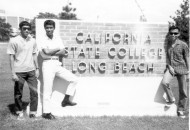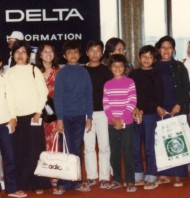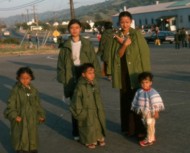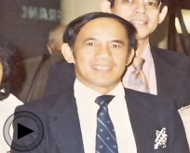Why Long Beach?
Susan Needham and Karen Quintiliani May, 2011 Why did Long Beach, California become home to one of the largest populations of Cambodians outside of Southeast Asia? As with all histories there is no single reason or event that made it inevitable. Many factors at local, national, and international levels played a role over an extended period of time. This website takes a step toward answering that question by presenting many of the people and events that have contributed to the establishment and growth of the Long Beach Cambodian community.
|
|
 California State University, Long Beach (CSULB) students (from left) Mamith Thong, Pheany Richard Chey, and Kheng Lay. Photo: c. 1962-64
|
1961 Cambodian Students attend CSU Long Beach
The history of Cambodians in the United States begins in the late 1950s with a USAID program which brought students to U.S. universities to train in industrial arts and agriculture. In 1961, California State University Long Beach admitted four Cambodian students into their Industrial Arts program. Students also attended California State University Los Angeles (CSULA), University of California Los Angeles (UCLA), and University of Southern California (USC). Cambodia held great promise following Independence from France in 1953 and most of the students who came to study in the United States during the 1960s returned home when they completed their degrees eager to participate in what should have been a bright future. Only a few students decided to stay in the United States.
|
 Drawing of the Khmer Rouge evacuating Phnom Penh, April 17, 1975.
|
1975 Khmer Rouge Takeover
In April 17, 1975, after five years of civil war which was exacerbated by U.S. involvement in the Vietnam War, the Khmer Rouge, a radical communist regime led by Pol Pot, took control of Cambodia. About 4,500 Cambodians were evacuated to the United States along with some 125,000 Vietnamese and 800 Hmong and Lao. Two military bases processed the evacuees arriving from Southeast Asia: Fort Chafee, Arkansas and Camp Pendleton, California, located about 70 miles south of Long Beach. The first of the evacuees arrived at Camp Pendleton on May 5, 1975.
|
|
Evacuees began arriving at Camp Pendleton, in May 1975. They arrived with nothing but the clothes they were wearing when they left Cambodia. The Southern California coastal area is cold and damp in spring. Several Marines loaned their coats to the new arrivals.
VideoMr. David Kreng |
Long Beach and Southern California The evacuees arrived at Camp Pendleton with nothing more than the clothes they were wearing when they escaped Cambodia. Only about ten Cambodian families and a few students were living in Southern California at the time. They immediately mobilized to assist the new arrivals. An organization called Khmer Solidarity of America (KSA) was formed to assist the evacuees and those Cambodians in other parts of the world who were unable to return to Cambodia. KSA letterhead used the Long Beach address of one of its members. The organization was renamed Cambodian Association of America (CAA) in late 1975. CAA still provides services in the Long Beach Cambodian Community today. CAA members personally sponsored many of the families who arrived in Camp Pendleton and helped them locate in Long Beach. In 1975, Greater Los Angeles and Long Beach in particular, offered much to the displaced Cambodians. Long Beach had entry level jobs in local industry and at the port. The City also had relatively inexpensive housing. Additionally, the Southern California climate is mild and with year-round gardening, Cambodians could grow the fruits, vegetables, and herbs they were accustomed to. Also, Los Angeles County had a well established Asian population with restaurants and markets providing many of the foods and services Cambodians enjoyed. The new community quickly became known as a “good place for Cambodians” and many people who had been sponsored to other parts of the country moved to Long Beach to be with family, friends, and compatriots who had already settled there.
Cambodians in the United States were deeply concerned about what was happening to family and friends left in Cambodia. Individuals and organizations lobbied the United States Congress and international aid organizations, such as the Red Cross, to help Cambodia. During this time a few people from Long Beach returned to the Cambodia/Thai border area to bring aid to those in border camps and to fight the Khmer Rouge.
|
 The Kem Family arrived at San Francisco airport before going to Long Beach. All their possessions were in the white carry-on. Important documents were in the ICM (Intergovernmental Committee for Migration) bag. Photo: c. 1980.
|
1979 Vietnamese Invasion and "Second Wave" of Cambodian Refugees
In late December 1978 the Vietnamese invaded Cambodia triggering what is referred to by scholars as the “second wave” of Cambodians to come to the United States. Between 1979 and 1986 nearly 130,000 Cambodians, now identified by the federal government as refugees, were admitted to the U.S.
|
 Built in 1991, the United Cambodian Community (UCC) building was the first major Cambodian construction project on Anaheim Street in the Cambodia Town area of Long Beach. Although no longer home to the UCC, it remains an important landmark in the community. |
Cambodians in the second wave however, had suffered four years of unimaginable physical and psychological trauma. Most people had lost at least one family member and many had lost their entire family to starvation, disease, or murder during the “Pol Pot Time.” Cambodians were attracted to Long Beach because of the established community with Cambodian businesses, Buddhist temples, and others who spoke Khmer (Cambodian), as well as a reliable network through which they could find work and a place to live. Thousands of people who had been initially resettled in small cities in Florida, Illinois, Massachusetts, New York, Ohio, Texas, Virginia, and Washington made their way to Long Beach to be reunited with family, friends, and others who shared their experience of trauma, displacement, and devastating loss.[i] By 1981 Long Beach was being identified as “the Cambodian capital of the United States.” [ii]
Cambodians initially settled in two areas of Long Beach - north Long Beach and along the Anaheim Street corridor between Redondo Ave. to the east and Long Beach Blvd. to the west. Cambodian businesses were established throughout Long Beach, but Anaheim Street hosts the highest concentration and is generally referred to as the “heart” of the community.
Cambodians have also settled in cities adjacent to Long Beach in Greater Los Angeles and Orange County. They support and actively participate in the Cambodian economy and cultural activities centered in Long Beach.
In a relatively short period of time Cambodians established businesses which included restaurants, gift shops, tailors, jewelers, auto repair, and the highly successful doughnut shops. Several Buddhist temples of varying sizes exist in the city. There are several Khmer language newspapers, television and radio stations and classes in Khmer language and classical dance.
|
|
Clockwise from upper left: Angkor Wat, 12th century Khmer temple; Buddha;classical dance; map of extent of Khmer Empire in 12th century. |
2,000 Years of Cambodian History
One of the most important things to keep in mind while exploring this website is that although the horrific events of the late 20th century are directly linked to the arrival of large numbers of Cambodians to the United States and Long Beach, Cambodians have a 2,000 year cultural history they have drawn from to rebuild their lives here. Because this ancient culture and its symbols are so important to Cambodians in Long Beach, and because a culture cannot be fully understood through just one activity or historical event, but needs to be understood as a system of values, attitudes, and beliefs which have developed over time, we have designed the website to provide as much cultural context as possible. Timelines and sections on the Arts, in particular dance and music; Religious Practices, including Buddhist and Christian; Key Organizations which contributed to the community’s growth; and Sports & Recreation, including martial arts and chess, contain text, photographs, and video clips designed to provide a historical context for Cambodian culture as it has been recreated in Long Beach.
|
|
The Cambodian Community History Archive Project
The CamCHAP website is a work-in-progress and we will continue adding topics, such as theater, food, language, celebrations, weddings, and more over time. We invite anyone who would like to contribute documents, books, video, or photographs to the CamCHAP archive or website to please contact us at the Historical Society of Long Beach, 562-424-2220, email:
|
|
| [i] Mortland, Carol and Judy Ledgerwood (1987) Secondary Migration among Southeast Asian Refugees in the United States. Urban Anthropology 16(3-4):291-326.
Further Reading
Chan, Sucheng and Audry Kim (2003) Not Just Victims: Conversations with Cambodian Community Leaders in the United States. Chicago: University of Illinois Press.
Needham, Susan and Karen Quintiani (2008) Cambodians in Long Beach. Mount Pleasant, SC: Arcadia Publishing.
Needham, Susan and Karen Quintiliani (2007) Cambodians in Long Beach, California: The Making of a Community. IN The Journal of Immigrant and Refugee Studies, 5(1):29-53. |
|

 ខ្មែរ
ខ្មែរ  English
English 

